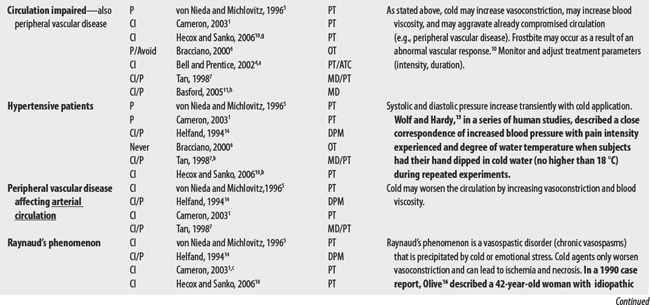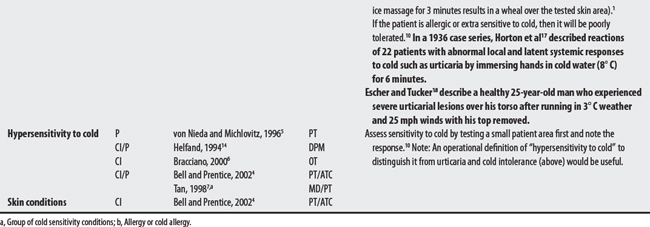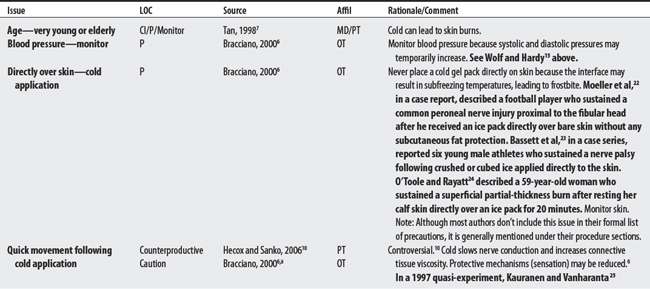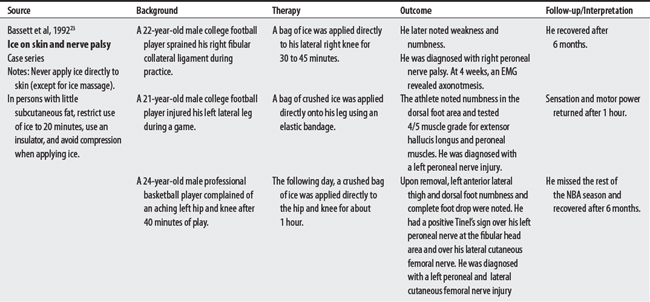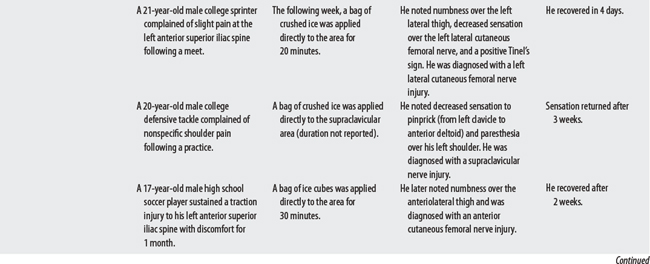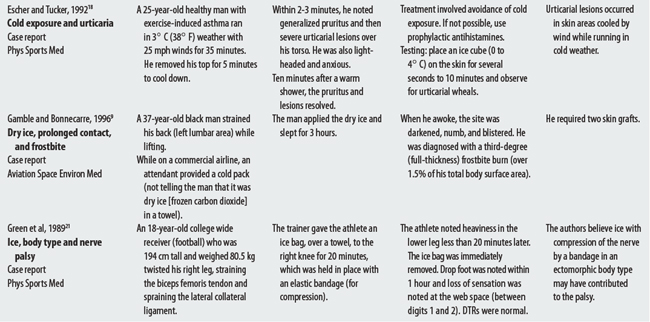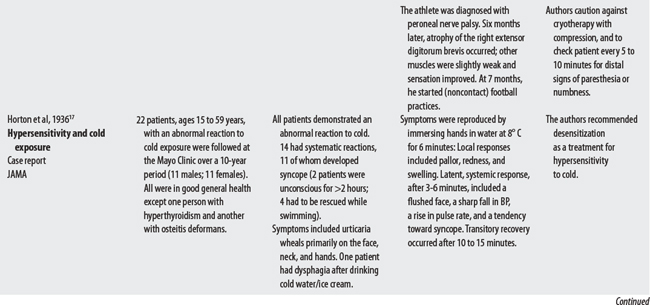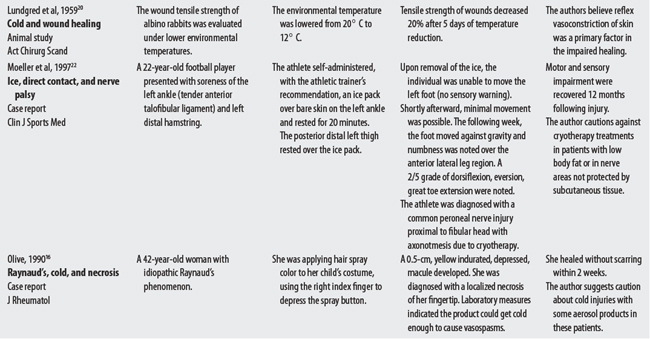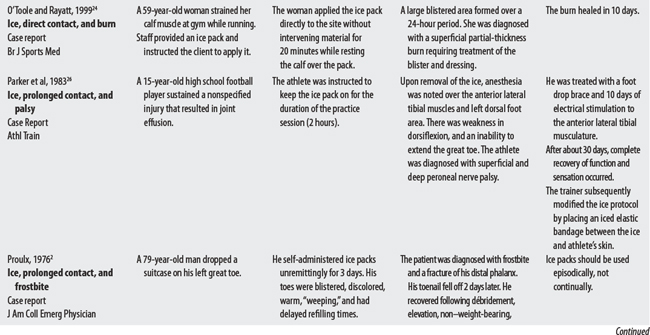Chapter 42 Cryotherapy (Cold Therapy)
OVERVIEW.
Cryotherapy involves the application of cold substances for the purposes of reducing blood flow and tissue metabolism and increase pain thresholds. Agents include cold packs, ice massage, and vapo-coolant spray.1
SUMMARY: CONTRAINDICATIONS AND PRECAUTIONS.
Notes: (1) Although not routinely listed under contraindication guidelines, protocols for cryotherapy generally limit its use to short durations (i.e., 15 to 20 minutes). Proulx2 describes a 79-year-old man who self-administered ice packs unremittingly for 3 days to his toe and subsequently sustained frostbite.
(2) Sources used a variety of terms to describe cold sensitivity: urticaria, sensitivity to cold, cold intolerance, cold hemoglobinuria, and cryoglobulins. In 1962, Shelley and Caro3 classified three main types of cold sensitivity: (1) Cold urticaria from cold-induced histamine release, (2) cold hemoglobinuria with the presence of cold agglutinins and hemolysis, and (3) presence of cryoglobulins that precipitate when blood is chilled.
CONTRAINDICATIONS AND PRECAUTIONS FOR CRYOTHERAPY
A00-B99 CERTAIN INFECTIONS AND PARASITIC DISEASES
D50-D89 DISEASES OF BLOOD AND BLOOD-FORMING ORGANS AND CERTAIN DISORDERS
F00-F99 MENTAL AND BEHAVIORAL DISORDERS
G00-G99 DISEASES OF THE NERVOUS SYSTEM
I00-I99 DISEASES OF THE CIRCULATORY SYSTEM
L00-L99 DISEASES OF THE SKIN AND SUBCUTANEOUS TISSUE
M00-M99 DISEASES OF THE MUSCULOSKELETAL SYSTEM AND CONNECTIVE TISSUE
S00-T98 INJURY, POISONING, AND CERTAIN OTHER CONSEQUENCES OF EXTERNAL CAUSES
1 Cameron MH. Physical agents in rehabilitation: from research to practice, ed 2. St. Louis: W.B. Saunders, 2003.
2 Proulx RP. Southern California frostbite. J Am Coll Emerg Phys. 1976;5(8):618.
3 Shelley WB, Caro WA. Cold erythema. JAMA. 1962;180:639-642.
4 Bell GW, Prentice WE. Infrared modalities. In: Prentice WE, editor. Therapeutic modalities for physical therapists. New York: McGraw-Hill, 2002.
5 von Nieda K, Michlovitz SL. Cryotherapy. In Michlovitz SL, editor: Thermal agents in rehabilitation, ed 3, Philadelphia: F.A. Davis, 1996.
6 Bracciano AG. Physical agent modalities: theory and application for the occupational therapist. Thorofare (NJ): Slack, 2000.
7 Tan JC. Practical manual of physical medicine and rehabilitation: diagnostics, therapeutics, and basic problems. St. Louis: Mosby, 1998.
8 Horwitz CA. Autoimmune hemolytic anemia. 3. Cold antibody type. Postgrad Med. 1979;66(4):189-193. 196-198, 200
9 Gamble WB, Bonnecarre ER. Coffee, tea, or frostbite? A case report of inflight freezing hazard from dry ice. Aviat Space Environ Med. 1996;67(9):880-881.
10 Hecox B, Sanko JP. Cryotherapy. In: Hecox B, Mehreteab TA, Weisberg J, editors. Integrating physical agents in rehabilitation. Upper Saddle River (NJ): Pearson Prentice Hall, 2006.
11 Basford JR. Therapeutic physical agents. Delisa JA, editor. Physical medicine and rehabilitation: principles and practices, ed 4, vol 1. Philadelphia: Lippincott Williams & Wilkins, 2005.
12 Collins KJ, Dore C, Exton-Smith AN, et al. Accidental hypothermia and impaired temperature homeostasis in the elderly. BMJ. 1977;1(6057):353-356.
13 Umphred DA, McCormack GL. Classification of common facilitatory and inhibitory treatment techniques. In: Umphred DA, editor. Neurological rehabilitation. St. Louis: Mosby, 1990.
14 Helfand AE. Physical modalities in the management of mild to moderate foot pain. Clin Podiatr Med Surg. 1994;11(1):107-123.
15 Wolf S, Hardy JD. Studies on pain. Observations on pain due to local cooling and on factors involved in the “cold pressor” effect. J Clin Invest. 1941;20:521-533.
16 Olive KE. Aerosol spray can induced cold injury in a patient with Raynaud’s phenomenon. J Rheumatol. 1990;17(4):556-557.
17 Horton BT, Brown GE, Roth GM. Hypersensitiveness to cold with local and systemic manifestation of a histamine-like character: its amenability to treatment. JAMA. 1936;107:1263.
18 Escher S, Tucker A. Preventing, diagnosing, and treating cold urticaria. Phys Sport Med. 1992;20(12):73-84.
19 Schmidt KL, Ott VR, Rocher G, et al. Heat, cold and inflammation. Z Rheumatol. 1979;38:391-404.
20 Lundgred C, Murren A, Zederfeldt B. Effects of cold vasoconstriction on wound healing in the rabbit. Acta Chirurg Scand. 1959;118:1.
21 Green GA, Zachazewski JE, Jordan SE. Peroneal nerve palsy induced by cryotherapy. Phys Sport Med. 1989;17(9):63-70.
22 Moeller JL, Monroe J, McKeag DB. Cryotherapy induced common peroneal nerve palsy. Clin J Sports Med. 1997;7(3):212-216.
23 Bassett FH, Kirkpatrick JS, Engelhardt DL, et al. Cryotherapy induced nerve injury. Am J Sports Med. 1992;22:516-528.
24 O’Toole G, Rayatt S. Frostbite at the gym: a case report of an ice pack burn. Br J Sports Med. 1999;33(4):278-279.
25 Kauranen K, Vanharanta H. Effects of hot and cold packs on motor performance of normal hands. Physiotherapy. 1997;83(7):340-344.
26 Parker JT, Small NC, Davis DG. Cold induced nerve palsy. Athl Train. 1983;18:76-77.
27 Steven DM, D’Angelo JA. Frostbite due to improper use of frozen gel pack. N Engl J Med. 1978;299(25):1415.
28 U.S. Food and Drug Administration. Center for Device and Radiological Health. Available at: http://www.fda.gov/cdrh/mdr/. Accessed November 7, 2005








